Fleahound
New member
- Joined
- Sep 14, 2007
- Messages
- 4
- Reaction score
- 0
- Points
- 0
- Location
- Alberta, Canada
- Country
- Canada
- Display Name
- Cheryl
Hello
I am from Alberta, Canada.
I have recently aquired a tiger salamander ("Waldo")
I joined the forum in order to access information from experienced keepers and to learn as much as possible about my new little critter.
I have set up a vivarium for him with plants, a pool, and a submersible filter that pumps water from one end of the tank, down a stream (constructed from pop bottles cut in half and filled with rocks) back down hill to the pool. The filter is located in a well on the dry end of the tank (yes, another pop bottle with the top cut off this time and holes cut into the bottom so the water can flow into it - the gaps are stuffed with some old fish tank sponges that I had so that Waldo will not get stuck down there). The filter creates a nice little water fall that he sometimes walks under. So far the ammonia and nitrites havent seemed to spike - I used fish tank gravel in the bottom under his hill that had a good bacterial population in it already so hopefully this will act as a good bio-filter for the pond. The plants, moss and java ferns will hopefully keep the nitrates from building up between water changes. Thankfully, I have a huge fish tank and I keep a 90gal tank of fresh / conditioned / dechlorinated water in the basement handy for water changes so I can change his water as often as I like. His water/tank temp is holding steady at about 19-20C. I will be changing the little fishtank rocks for large ones when I need to change the coconut fibre bedding that is layered on top of them. I used those because they were handy and I wanted to establish a healthy bacterial population for waste management. I hand feed Waldo with tweezers so hopefully he won't swallow any rocks in the meantime.
I have been feeding Waldo a combination of wax worms, butter worms, earth worms and pink mice. I have been feeding him 2 times per week. I have an aversion to crickets so hopefully he will do okay nutritionally without them in his diet.
He spends time in his cave during the day and usually comes to the "door" and peers at me when I walk by his tank. He burrows about in the moss and plants at night and is sometimes moseying about during the daytime as well. He is pretty social and likes to pose for pictures - especially if he thinks that food may be forthcoming.
I hope that I can learn lots of new information, get useful suggestions from those more experienced than myself and chat with some interesting people with similar interests on this site.

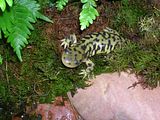
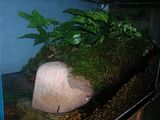
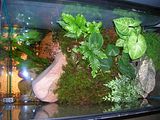
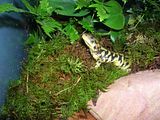
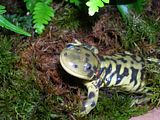
Oh, and here is Waldo - the photogenic salamander
Have a great evening!
